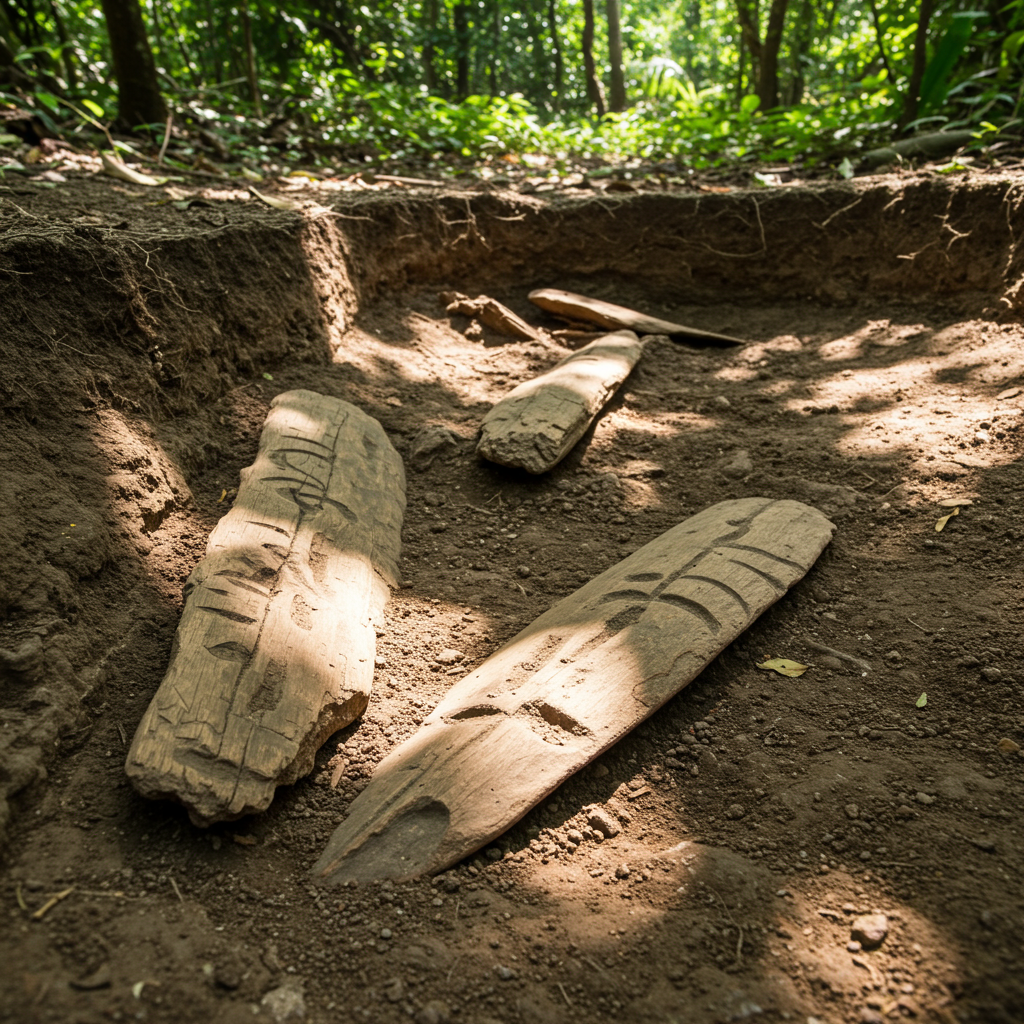A groundbreaking archaeological discovery in southwest China is reshaping our understanding of prehistoric technology and diet in East Asia. Researchers have unearthed a remarkable collection of wooden tools, skillfully crafted by early hominins an astonishing 300,000 years ago. Unlike most ancient wooden artifacts found elsewhere, these tools were specifically designed for harvesting plants, revealing a sophisticated reliance on vegetation by communities living in this subtropical environment. This finding directly challenges previous assumptions about technological progress in Paleolithic East Asia.
For decades, many archaeologists believed that technological innovation in East Asia lagged behind Europe during the Middle Palaeolithic period, roughly 300,000 years ago. While Europe saw rapid advancements in stone tool technology, East Asia’s stone artifacts appeared relatively unchanged until modern humans arrived much later. This led to the assumption that the region’s prehistoric inhabitants were technologically less advanced.
However, the recent discovery at the Gantangqing site near a former lakeside fundamentally alters this view. Professor Bo Li, a lead author of the study, highlighted this impact. He stated that the collection “really revolutionizes our understanding of the technique and the cultural industry of Paleolithic East Asia.” It provides tangible evidence of complex toolmaking and strategic planning occurring in the region much earlier than previously thought possible.
The Gantangqing assemblage includes 35 distinct wooden artifacts. These items clearly show signs of intentional shaping and use by early humans. Evidence includes telltale whittling marks, smoothed surfaces, and knots deliberately worked into the design.
The tools were precisely dated using advanced methods analyzing feldspar minerals in the surrounding sediment. This technique provided a manufacturing timeframe for the tools between 361,000 and 250,000 years ago. This places them firmly in a period where hominins other than Homo sapiens were present in the region.
Most of the tools are made from pine wood, although a few exceptions utilize harder woods. The collection features larger digging sticks, likely used to access underground plant resources. It also includes smaller, hook-like implements. These smaller tools may have been designed for slicing through tough plant roots and tubers.
Finding wooden tools from such a distant past is incredibly rare. Wood decomposes relatively quickly over long periods. This means the archaeological record is heavily skewed towards stone artifacts, which survive much better. The exceptional preservation conditions at the Gantangqing site made this discovery possible.
Many rare Pleistocene wooden artifacts found globally are hunting weapons. Famous examples include the 400,000-year-old spear tip from Clacton-on-Sea in England and the renowned Schöningen spears from Germany, dated to 200,000-300,000 years ago. The Schöningen spears, through analysis of their balance points, are considered strong evidence for projectile hunting technology around 300,000 years ago.
In stark contrast, the Gantangqing tools point to a primary focus on gathering. The study authors emphasized this difference. They described the Gantangqing assemblage as presenting “a scenario of early hominin subsistence in subtropical and tropical environments that is plant-oriented.” This contrasts sharply with northern temperate sites like Schöningen, where hunting large mammals was clearly dominant.
The researchers’ analysis suggests that the hominins at Gantangqing were highly strategic. They made planned visits to the lakeshore. They brought with them specific, fabricated tools crafted from selected types of wood. Their purpose was to efficiently exploit underground food sources.
These sources included tubers, rhizomes, or corms. Based on plant remains found around the site, their diet likely incorporated items such as kiwis, nuts, and various types of underground storage organs. This reinforces the significant importance of plant foods in the diet of early hominins inhabiting subtropical regions.
The fascinating question remains: who were these skilled toolmakers? Professor Bo Li suggests “the most likely candidate is denisovans.” The increasing discovery of Denisovan fossils across East Asia supports this hypothesis. Denisovans are an extinct group of hominins closely related to both modern humans and Neanderthals.
Evidence places Denisovans in East Asia during the relevant time period. This includes the Harbin fossil, dated over 150,000 years old, and finds from the Tibetan Plateau over 190,000 years ago. Additional evidence comes from Penghu in the Taiwan region and sites in Laos. This growing fossil record indicates that Denisovans likely occupied this vast region throughout the Middle Paleolithic.
Denisovans were far from primitive. Genetic evidence shows they interbred with both Neanderthals and early Homo sapiens. The discovery of a hybrid individual (“Denny”) with a Neanderthal mother and a Denisovan father in Siberia confirms this interaction. They shared a common ancestor, likely Homo heidelbergensis, which lived around 600,000 to 750,000 years ago. While fossil remains are scarce, suggesting they had physical similarities to us, studies attempting reconstruction from DNA suggest they may have had particularly wide faces.
Professor Bo Li also noted their intelligence and capability. “Denisovans co-existed with Neanderthals in Siberia and made very sophisticated stone tools like Neanderthals,” he explained. “So there’s no question that they are smart, they are intelligent, they are advanced.” This known capacity for complex toolmaking makes them highly plausible creators of the sophisticated wooden foraging tools found in China.
The discovery at Gantangqing is a significant step in understanding early hominin life. It highlights technological sophistication in East Asia previously underestimated. It provides rare insight into ancient plant-based diets and foraging strategies. Most compellingly, it strengthens the case for Denisovans as intelligent, resourceful inhabitants of the region who developed specialized tools adapted to their environment.
Frequently Asked Questions
What are the key features of the ancient wooden tools found in China?
The collection unearthed at the Gantangqing site in southwest China includes 35 wooden tools dating back about 300,000 years. Mostly made of pine with some hardwood, they show clear evidence of deliberate shaping, including whittling marks and smoothed surfaces. Unlike many ancient wooden artifacts, these tools were designed for harvesting plants, featuring items like digging sticks and smaller tools possibly used for cutting roots.
Why is the discovery of 300,000-year-old wooden tools in East Asia significant?
This discovery is significant because it challenges the long-held belief that technological innovation in Paleolithic East Asia lagged behind Europe. The sophisticated craftsmanship and specialized function of these tools demonstrate advanced technical skill and strategic thinking by early hominins in the region at a much earlier date than previously assumed. It revolutionizes our understanding of East Asian Paleolithic culture and industry.
Why do scientists think Denisovans might have made these tools?
The lead researchers propose Denisovans as the most likely toolmakers based on mounting fossil evidence placing Denisovans throughout East Asia during the 300,000-year timeframe of the tools. Finds in locations like Harbin, the Tibetan Plateau, Penghu, and Laos indicate their presence. Denisovans are known to have been intelligent and capable toolmakers, co-existing with and creating sophisticated tools similar to Neanderthals, making them plausible creators of the advanced wooden technology found at Gantangqing.



